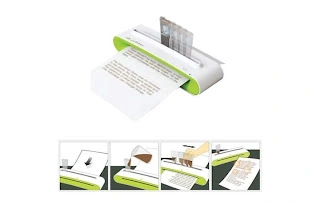Imagine a scene. After drinking coffee one morning, the coffee grounds collected at the bottom of the cup are poured into the printer cartridge instead of being thrown into the waste basket, where the coffee grounds instantly turn to ink. This innovative idea is going to be the basis of a great eco-friendly printer for the next generation. Its name is Riti Coffee Printer.
Nowadays there is a trend towards making electrical devices more environmentally friendly. This coffee printer is part of that growing creativity.
These devices do not use any toxic compounds. and uses materials that are essentially reusable. The use of bioplastic methods is increasingly seen in gadgets. At the Greener Gadgets conference held in 2008, computer industry giant HP presented a printer made with a corn-based bioplastic process.
A lot of wastage occurs in conventional inkjet printers. If you heed the printer’s warning message and buy a new cartridge, you’ll waste about 58 percent of your ink on average. In addition, the printer’s “cleaning” program also increases ink consumption.
This is not the end of the problem, most people do not recycle printer cartridges. As a result, about 27 million printer cartridges made of plastic, metal, rubber and other materials end up in landfills every year.
Most printer inks are primarily mineral oil or petroleum-based. In other words, just as our transportation sector and manufacturing of plastics require a lot of oil, so too does the production of printer ink and toner. About 45,359 metric tons of black gold are used every year for printers alone.
In addition, hazardous chemicals are created during the production of petroleum-based inks. These are known as volatile organic compounds (VOCs). These pollutants can leach into the air and groundwater. and can cause a variety of acute or chronic health problems.
Now that we know the problems with conventional inks, let’s get to know some of the advantages of coffee printers.
Advantages Of Coffee Printers
The coffee printer is designed to be as environmentally friendly as possible. As a result, the current design consumes very little power. Some electricity will be required, at least to light the LED lights on the outside of the device and to pull the paper into the printer.
Printers generally require heat to print digital images onto paper. But the coffee printer can draw power from a computer using a standard USB connection. And of course, the necessary instructions for printing can be sent from the computer to these printers. However, most inkjet printers do not have this feature and require a standard power cable.
The best part of this design printer is that it uses a household product that would otherwise go to waste. In this method, printer ink is being made at home by mixing water with already used coffee powder.
And printers can use coffee grounds or coffee powder as well as tea residue. Coffee or tea powder is mixed with water and poured into a reusable ‘ink case’ or ‘ink reservoir’. It is much cost effective compared to conventional disposable cartridges.
But how do you print a mixture of coffee or tea residue and water on paper?
This magical idea is still in the planning stage, so we can’t test it in depth. But, there is some work to be done from its basic concept. This means that basically its ink case can move back and forth. This is how the coffee or tea color drips onto the paper to create writing or images.
The work is a bit of work. However, many people may find this activity of printing using coffee grounds interesting. Because it gives them more control over the printing process. Through this method, the process of printing becomes a skill-based industry.
After printing with coffee grounds, you can reuse them. Many people use coffee grounds as organic fertilizer. To make the most of coffee grounds, use them for printing before composting.
Printer ink cartridges are usually very expensive. Surely ink made from your waste would be much more affordable than that? And you no longer have to go to the store to buy ink, spend time searching for good cartridges, and worry about recycling old cartridges.
Conventional printers tend to give misleading warning messages about ink being depleted long before it runs out. But with coffee printers you can clearly see when the ink supply is low.
Disadvantages Of Coffee Printers
Coffee printer technology has a lot of potential for success. That doesn’t mean it’s free of all sorts of flaws. Even at its planning stage, critics have pointed out some flaws. Chief among its design flaws is that ink color and quality are highly user dependent. Besides, there is doubt whether this coffee ink will stay on the paper for a long time like other conventional inks. The coffee smell may linger after printing, although some users may prefer this familiar, earthy smell.
Also, consumption can really become an issue, as a handful of coffee grounds can’t produce much ink. Let’s assume, however, that you have enough coffee grounds to load the ink. Even so, loading ink is a risky process, requiring physical labor and time, and the ink may even spill out.
Can such a device survive? The current design is going to convert the printing process to “painting” using coffee ink. Obviously, this will not be an efficient way to produce clear text and clear images. Also, having to manually remove the cartridge every 10 or 20 pages would not be pleasant at all.
If conventional printers are also made to accept such ink, the ink supply remains limited to your coffee or tea consumption. Also, you cannot print in black or other colors without adding additional dyes.
There are already many eco-friendly inks available as alternatives to conventional inks. Among these are vegetable-oil inks and metal-free inks. Inks derived from vegetable oils are often considered environmentally friendly and sustainable because they do not produce harmful volatile organic compounds (VOCs). Moreover, they are available from a variety of crops.
An ink made from soybean oil is widely used as a major alternative to many inks made from mineral oil or petroleum.
In the late 1970s, the United States experienced an oil crisis. In response, the American Newspaper Association introduced soybean oil inks in 1987. Currently, this ink is used across 22.5 percent of the US printing market. It is very affordable and 90 percent of U.S. newspapers use soybean ink, especially for color prints.
A variety of soybean-based inks are also available for home and office printers. In fact, soybean ink has recently become very successful and popular. However, be careful. Because some fake inks called soybean inks have actually come out with a small amount of soybeans, the rest is filled with petroleum-based inks.





